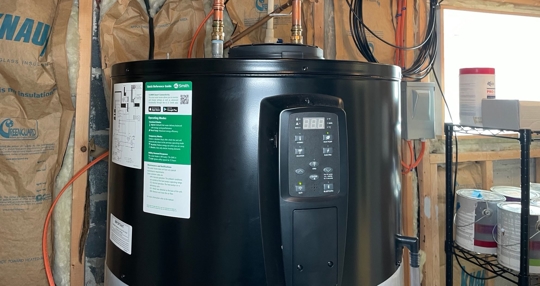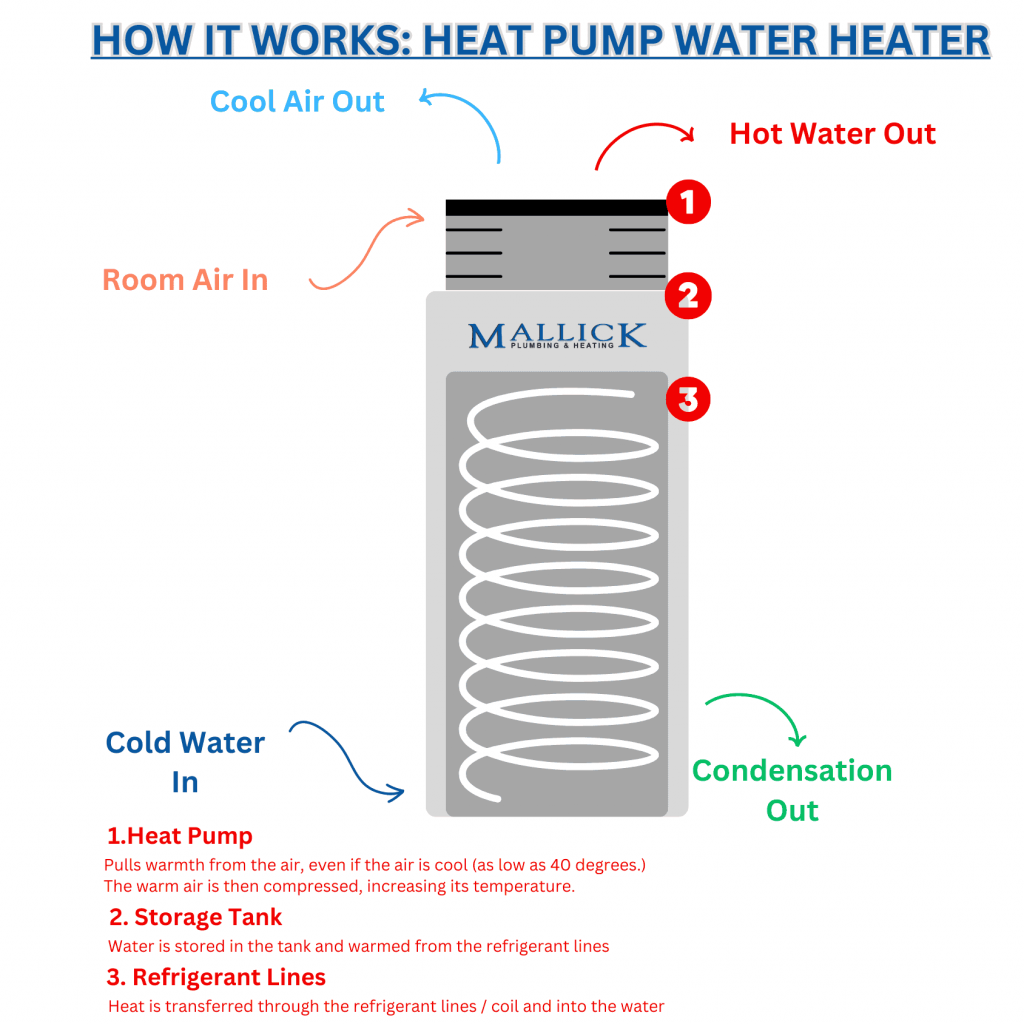
What is a Heat Pump Water Heater?
Instead of generating heat directly – like a traditional electric or gas water heater – a Heat Pump Water Heater operates by using a heat pump to extract the heat from the surrounding air and heating the water within the tank through the coil surrounding it.
The entire process is roughly three times more efficient than a traditional electric water heater because no new heat is generated by the water heater – just transferred. And depending on the model and usage, a Heat Pump Water Heater can reduce your energy bills by up to 78%!
What are the Benefits of Heat Pump Water Heaters?
There are many benefits to adding a Heat Pump Water Heater, including:
- Energy Efficiency: Heat Pump Water Heaters are more energy-efficient than traditional electric or gas water heaters. By transferring heat from the air rather than generating the heat directly, Heat Pump Water Heaters use less energy to heat the same amount of water. This can result in lower energy bills and cost savings over time for homeowners.
- Reduced Carbon Footprint: With the ability to use less energy, Heat Pump Water Heaters help reduce greenhouse gas emissions and produce a lower carbon footprint than traditional water heaters.
- Rebates Available: Depending on the Heat Pump Water Heater’s manufacturer and your home’s location, rebates are available for homeowners to take advantage of. Many state and local governments offer rebates and incentives for homeowners to install energy-efficient Heat Pump Water Heaters. You should contact your utility company to understand what rebates are available for you.
For homeowners in Maryland, here are a few rebates you may be eligible for:
- Utility rebates through Pepco and Potomac Edison
- Up to $2,000 in Federal Tax Credits, for those eligible
By abandoning a traditional gas water heater and upgrading to a Heat Pump Water Heater, homeowners can avoid additional maintenance and cost associated with a chimney lining or repair.
What is the Disadvantage of Heat Pump Water Heaters?
A few things to consider with a Heat Pump Water Heater:
- Operating Noise: One of the most common concerns homeowners have with Heat Pump Water Heaters is the operating noise. The average Heat Pump Water Heater will produce anywhere from 45-50 decibels, which is equivalent to the humming a standard refrigerator will make. If you’re still concerned with the noise a Heat Pump Water Heater will make, speak to one of our knowledgeable Mallick Plumbing & Heating technicians to better understand which model would be best suited for your home.
- Space Required: While Heat Pump Water Heaters and traditional water heaters have the same amount of water storage, Heat Pump Water Heaters stand a little taller due to the heat pump that sits on top of the storage tank. This could limit certain heater locations or require some alterations, which Mallick Plumbing & Heating will be able to recognize and make recommendations for.
- Condensation Production: With Heat Pump Water Heaters, condensation is natural. When the unit pulls air from the surrounding environment, the heat is removed and causes the air to be cooled, leading to the production of condensation. For this reason, Heat Pump Water Heater require a condensation line – unlike traditional water heaters. This line can lead into drains but can sometimes require a few more modifications that our Mallick Plumbing & Heating technicians can help modify to your home and unit’s location.
- Chimney Maintenance: For customers utilizing gas to heat their water, regular chimney maintenance is recommended – which can lead to chimney lining or repairs. Based on your location, a chimney liner may be required with the installation of a natural draft / gas water heater.
Do Heat Pump Water Heaters Work in Cold Climates?
Heat Pump Water Heaters do work in cold climates. However, they are designed to take the heat from the surrounding air to warm the water in the tank. With colder air, Heat Pump Water Heaters require more energy, impacting the system’s efficiency. It is recommended Heat Pump Water Heaters are located in areas between temperatures of 40-90 degrees Fahrenheit, depending on the model.

